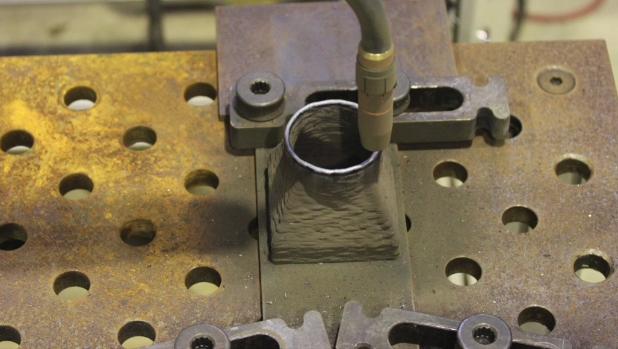Additive Metal Layering Technologies (AMLTECH), a 3D printed metal parts manufacturer based in Adelaide, Australia, has received a share of $8.51 million (USD) in grants offered by the nation’s Entrepreneurs Accelerating Commercialisation program.
Specializing in a trademark Wire-Arc Additive Manufacturing (WAM) process, AMLTECH has been selected by the government to establish a large scale metal 3D printing service within the region.
Metal parts with 75% less waste
WAM at AMLTECH is a process based on traditional welding. It uses a metal wire feedstock that melts on contact with a heated electrical charge, know as the “arc”. CAD modeled objects are free-formed in the technique by a robotic arm, allowing the creation of large parts used in automotive, aerospace and other metalwork industries.
Wire-arc additive manufacturing provided by Additive Metal Layering Technologies (accelerated clip). Clip via: LlamaVision on YouTube
With its foundations in a method first developed in the 1800s, WAM is compatible with a number of materials including titanium, nickel alloys, stainless steels and aluminum. Compared to traditional machining methods, “wastage of material is reduced by up to 80%” in AMLTECH’s WAM process, and “manufacturing times are reduced by 75%,” producing parts in days or even hours, rather than weeks.
Next-level welding
Andy Sales is the Managing Director and Founder at AML Technologies. Speaking to New Zealand’s Marlborough Express, Sales explains his motives for the company,
Performing welding techniques for 3D printing is a new and unique field, so this is what drives me, to do something different with welding than what is normally done or expected.

On receiving $376,200 (USD) from the government he says,
Being awarded the grant also validates our business plan immensely and provides confidence in the market place and for our small numbers of investors.
By scaling the robotic arms used to direct WAM metal, the aim is to “build something as big as a car” and bigger, as aerospace and maritime are other key areas for this technology.
The additive manufacturing technique is more widely known as WAAM, and was pioneering by the UK’s Cranfield University. WAAM is employed in the construction of large scale metal components for boats in Rotterdam’s Additive Manufacturing Lab (RAMLAB). A WAAM hybrid approach is also under development by 3D Metalforge at the first end-to-end metal 3D printing facility in Singapore.
To stay updated with all the latest 3D printing news, subscribe to the most widely read newsletter in the 3D printing industry, follow us on twitter and like us on Facebook.
Featured image: Sample of wire-arc 3D printed metal. Photo via AML Technologies



